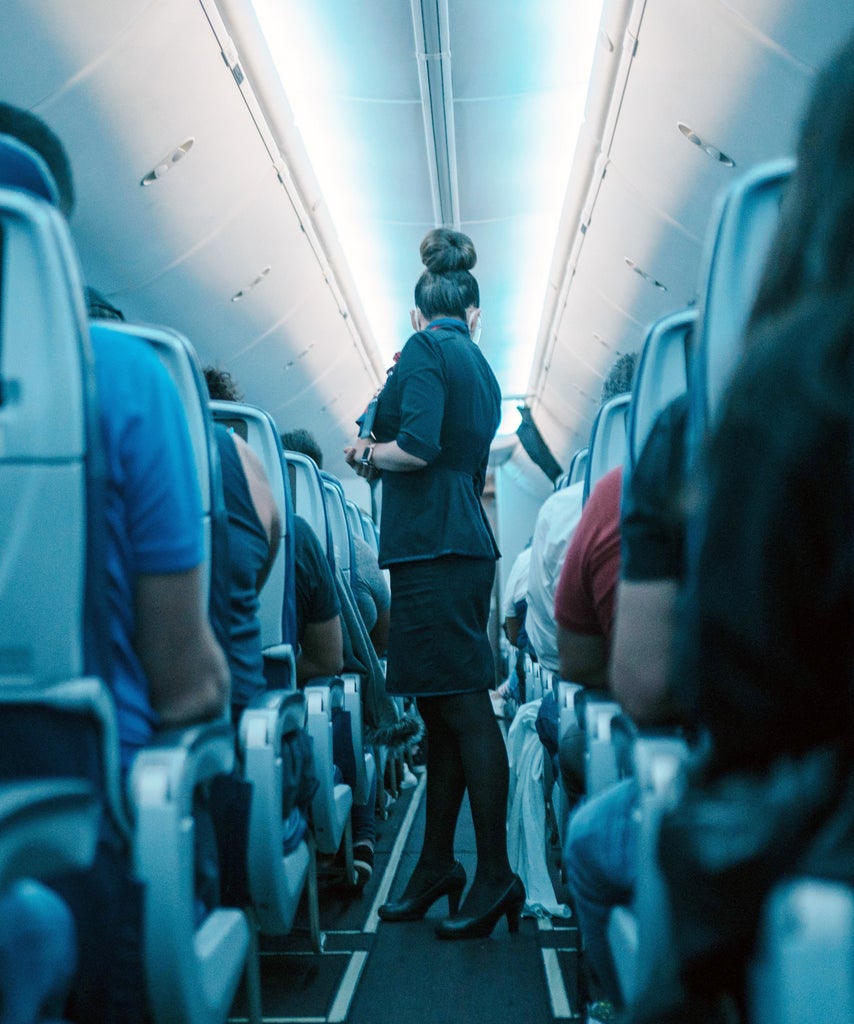
Even as air travel becomes more commonplace again, the number of people flying is still significantly lower than it was before the COVID-19 pandemic. That said, the number of people fighting on planes — assaulting each other, verbally and physically abusing crew members, and generally causing a scene — is higher than ever.
According to data from the Federal Aviation Administration, airlines have reported around 3,000 instances of “disruptive passengers” this year, a “significant increase” that started in late 2020. The FAA didn’t track this data in previous years because the numbers were previously “consistent.” But now, fights are becoming more frequent and more dangerous. “People are at stress level 10 coming out of this pandemic,” Sara Nelson, president of the Association of Flight Attendants (AFAC-CWA), tells Refinery29. Nelson also sent Refinery29 the following statement: “We’ve never before seen aggression and violence on our planes like we have in the past five months. Already, reports of these incidents in less than five months are more than 60 times the amount in a typical year. But these are just the incidents reported.”
As CBS News reported, the FAA usually investigates around 140 cases of airline violence a year. In 2021, the FAA had investigated almost 400 incidents by the end of May. Last month, in an attempt to send a message that violence wouldn’t be tolerated onboard, the agency proposed over $258,000 in total fines. But with fewer people flying anyway, how did things get so bad, so fast?
Numbers show that many of the fights reportedly start with clashes over the federal mask mandate, which requires that all travelers continue to cover their faces on public transportation until September 13. (Plane passengers can briefly remove their masks while drinking or eating.) And, the FAA said that, of the 3,000 recorded incidents, 2,300 involved people who “refused” to obey the mask mandate. Nelson also says many passengers become livid and violent when asked to mask up. “The constant combative attitude over wearing masks is exhausting and sometimes horrific for the people who have been on the frontlines of this pandemic for over a year,” she said in her statement, a version of which had already been published on the AFA-CWA site.
Not all of the cases are mask-related, though. In one viral video, which started making the rounds on May 27, a woman is seen attacking and punching a flight attendant who asked her to wear a seatbelt; the flight attendant lost two teeth. In February, one JetBlue traveler body-slammed an attendant and nearly pushed him into the bathroom after he prohibited her from taking complimentary items meant for first-class passengers. And one flight attendant says he received a concussion while trying to break up an abrupt brawl between three passengers.
“We are all more traumatized than we realize, and that puts people on edge,” Raymond Tafrate, PhD, a psychologist who has studied anger, told CBS News. According to Dr. Tafrate, the pervasive anger and tension related to COVID-19 might make people want to lash out: “The pandemic isolated people and caused all sorts of stress and problems in their lives. People are in worse shape than they were before.”
Many psychologists and trauma specialists agree that, along with depression and fatigue, rage is a common reaction to the collective trauma of the past 15 months. One study showed that more and more Americans started describing themselves as “angry” and “frustrated” as the pandemic went on. This rage and frustration can make people more volatile.
“We’re definitely seeing tensions heightened in families: domestic violence, domestic abuse. There’s some indication of child mistreatment increasing,” David H. Rosmarin, PhD, a clinician at McLean Hospital and assistant professor of psychology at Harvard Medical School, told The Harvard Gazette. “People are more on edge and one of the ways that they express that is through anger, which obviously is not healthy.”
Dr. Rosmarin recalled going for a run in Boston, and a stranger yelling at him to take off his mask. Later, while he was running without a mask, a stranger yelled at him for ditching it. Although some people might expect the airplane flights to slow down once the mask mandate is lifted in September, it’s also possible that the ongoing tension between anti-maskers and other people could lead to even more confrontations.
On Monday, a group of transportation, flight attendant, and pilot unions wrote a letter to Attorney General Merrick Garland, calling for support amid the “substantial increase” in violence and abuse on planes. “These incidents pose a safety and security threat to our passengers and employees, and we respectfully request that the Department of Justice commit to the full and public prosecution of onboard acts of violence,” wrote the coalition.
Some airlines are taking action to curb the violence, too. American and Southwest Airlines both announced that they would not be serving alcohol on flights, in an attempt to prevent unruly and aggressive behavior. “Alcohol can contribute to atypical behavior from customers onboard, and we owe it to our crew not to potentially exacerbate what can already be a new and stressful situation for our customers,” wrote American Airlines, according to The New York Times.
In a statement given to CBS News, Nelson said that steps like banning alcohol and putting certain violent passengers on no-fly lists is a start, but more needs to be done to protect crew members. “All of that is helpful, and if we didn’t have that I can only imagine how much worse it would be,” Nelson said, per CBS News. “But this is clearly not taking care of the whole problem. We have to do a lot more. I have never, ever seen an environment like this.”
Like what you see? How about some more R29 goodness, right here?
Was Your American Airlines Flight Just Canceled?
Was There Really A Man In A Jetpack In The Sky?
What Is Revenge Travel? You're About To Find Out
from Refinery29 https://ift.tt/2UvUuey
via IFTTT
